Optical Scattering of Liquid Gallium Nanoparticles Coupled to Thin Metal Films
Abstract
:1. Introduction
2. Methods
3. Results and Discussion
3.1. Dark-Field Scattering Properties of Liquid Ga NPs Coupled to an Au Film
3.2. Au Film-Coupled Liquid Ga NPs Excited by SPPs
3.3. Ag Film-Coupled Ga NPs for Color Display
4. Conclusions
Author Contributions
Funding
Conflicts of Interest
Abbreviations
| Ga | gallium |
| Au | gold |
| Ag | silver |
| SPPs | surface plasmon polaritons |
| NP | nanoparticle |
| MBE | molecular beam epitaxy |
| K-R | Kretschmann-Raether |
| SEM | scanning electron microscopy |
| CCD | charge coupled device |
| FDTD | finite-difference time-domain |
| GaO | gallium trioxide |
| SiO | silica |
| SnO | stannic dioxide |
References
- Spells, K.E. The determination of the viscosity of liquid gallium over an extended nrange of temperature. Proc. Phys. Soc. 1936, 48, 299. [Google Scholar] [CrossRef]
- Hardy, S.C. The surface tension of liquid gallium. J. Cryst. Growth 1985, 71, 602–606. [Google Scholar] [CrossRef]
- Tang, S.Y.; Khoshmanesh, K.; Sivan, V.; Petersen, P.; O’Mullane, A.P.; Abbott, D.; Mitchell, A.; Kalantar-zadeh, K. Liquid metal enabled pump. Proc. Natl. Acad. Sci. USA 2014, 111, 3304–3309. [Google Scholar] [CrossRef] [PubMed] [Green Version]
- Koo, H.J.; So, J.H.; Dickey, M.D.; Velev, O.D. Towards All-Soft Matter Circuits: Prototypes of Quasi-Liquid Devices with Memristor Characteristics. Adv. Mater. 2011, 23, 3559–3564. [Google Scholar] [CrossRef]
- Sivan, V.; Tang, S.Y.; O’Mullane, A.P.; Petersen, P.; Eshtiaghi, N.; Kalantar-zadeh, K.; Mitchell, A. Liquid metal marbles. Adv. Funct. Mater. 2013, 23, 144–152. [Google Scholar] [CrossRef]
- Tang, S.Y.; Sivan, V.; Petersen, P.; Zhang, W.; Morrison, P.D.; Kalantar-zadeh, K.; Mitchell, A.; Khoshmanesh, K. Liquid metal actuator for inducing chaotic advection. Adv. Funct. Mater. 2014, 24, 5851–5858. [Google Scholar] [CrossRef]
- Sheng, L.; Zhang, J.; Liu, J. Diverse transformations of liquid metals between different morphologies. Adv. Mater. 2014, 26, 6036–6042. [Google Scholar] [CrossRef]
- Zhang, J.; Sheng, L.; Liu, J. Synthetically chemical-electrical mechanism for controlling large scale reversible deformation of liquid metal objects. Sci. Rep. 2014, 4, 7116. [Google Scholar] [CrossRef] [Green Version]
- Zhang, J.; Yao, Y.; Sheng, L.; Liu, J. Self-fueled biomimetic liquid metal mollusk. Adv. Mater. 2015, 27, 2648–2655. [Google Scholar] [CrossRef]
- Zhang, J.; Guo, R.; Liu, J. Self-propelled liquid metal motors steered by a magnetic or electrical field for drug delivery. J. Mater. Chem. B 2016, 4, 5349–5357. [Google Scholar] [CrossRef]
- Tang, J.B.; Wang, J.J.; Liu, J.; Zhou, Y. Jumping liquid metal droplet in electrolyte triggered by solid metal particles. Appl. Phys. Lett. 2016, 108, 223901. [Google Scholar] [CrossRef] [Green Version]
- Yuan, B.; Wang, L.; Yang, X.H.; Ding, Y.J.; Tan, S.C.; Yi, L.T.; He, Z.Z.; Liu, J. Liquid Metal Machine Triggered Violin-Like Wire Oscillator. Adv. Sci. 2016, 3, 1600212. [Google Scholar] [CrossRef] [PubMed]
- Ghigna, P.; Spinolo, G.; Parravicini, G.B.; Stella, A.; Migliori, A.; Kofman, R. Metallic versus covalent bonding: Ga nanoparticles as a case study. J. Am. Chem. Soc. 2007, 129, 8026–8033. [Google Scholar] [CrossRef] [PubMed]
- Bosio, L. Crystal structures of Ga (II) and Ga (III). J. Chem. Phys. 1978, 68, 1221–1223. [Google Scholar] [CrossRef]
- Yarema, M.; Wörle, M.; Rossell, M.D.; Erni, R.; Caputo, R.; Protesescu, L.; Kravchyk, K.V.; Dirin, D.N.; Lienau, K.; von Rohr, F.; et al. Monodisperse colloidal gallium nanoparticles: Synthesis, low temperature crystallization, surface plasmon resonance and Li-ion storage. J. Am. Chem. Soc. 2014, 136, 12422–12430. [Google Scholar] [CrossRef] [PubMed]
- Li, X.F.; Fei, G.T.; Chen, X.M.; Zhang, Y.; Zheng, K.; Liu, X.L.; Zhang, L.D. Size-temperature phase diagram of gallium. EPL 2011, 94, 16001. [Google Scholar] [CrossRef]
- Parravicini, G.B.; Stella, A.; Ghigna, P.; Spinolo, G.; Migliori, A.; d’Acapito, F.; Kofman, R. Extreme undercooling (down to 90 K) of liquid metal nanoparticles. Appl. Phys. Lett. 2006, 89, 033123. [Google Scholar] [CrossRef]
- Breaux, G.A.; Hillman, D.A.; Neal, C.M.; Benirschke, R.C.; Jarrold, M.F. Gallium cluster “magic melters”. J. Am. Chem. Soc. 2004, 126, 8628–8629. [Google Scholar] [CrossRef]
- Steenbergen, K.G.; Gaston, N. First-principles melting of gallium clusters down to nine atoms: Structural and electronic contributions to melting. Phys. Chem. Chem. Phys. 2013, 15, 15325–15332. [Google Scholar] [CrossRef]
- Soares, B.F.; Jonsson, F.; Zheludev, N.I. All-optical phase-change memory in a single gallium nanoparticle. Phys. Rev. Lett. 2007, 98, 153905. [Google Scholar] [CrossRef] [Green Version]
- Zheludev, N.I.; Kivshar, Y.S. From metamaterials to metadevices. Nat. Mater. 2012, 11, 917–924. [Google Scholar] [CrossRef] [PubMed]
- Blaber, M.G.; Engel, C.J.; Vivekchand, S.; Lubin, S.M.; Odom, T.W.; Schatz, G.C. Eutectic liquid alloys for plasmonics: Theory and experiment. Nano Lett. 2012, 12, 5275–5280. [Google Scholar] [CrossRef] [PubMed]
- Gutiérrez, Y.; Losurdo, M.; García-Fernández, P.; Sainz de la Maza, M.; González, F.; Brown, A.S.; Everitt, H.O.; Junquera, J.; Moreno, F. Gallium Polymorphs: Phase-Dependent Plasmonics. Adv. Opt. Mater. 2019, 7, 1900307. [Google Scholar] [CrossRef]
- Geddes, C.D. Metal-Enhanced Fluorescence; John Wiley & Sons: Hoboken, NJ, USA, 2010. [Google Scholar]
- Stiles, P.L.; Dieringer, J.A.; Shah, N.C.; Van Duyne, R.P. Surface-enhanced Raman spectroscopy. Annu. Rev. Anal. Chem. 2008, 1, 601–626. [Google Scholar] [CrossRef] [PubMed] [Green Version]
- Naik, G.V.; Shalaev, V.M.; Boltasseva, A. Alternative plasmonic materials: Beyond gold and silver. Adv. Mater. 2013, 25, 3264–3294. [Google Scholar] [CrossRef]
- Albella, P.; Garcia-Cueto, B.; González, F.; Moreno, F.; Wu, P.C.; Kim, T.H.; Brown, A.; Yang, Y.; Everitt, H.O.; Videen, G. Shape matters: Plasmonic nanoparticle shape enhances interaction with dielectric substrate. Nano Lett. 2011, 11, 3531–3537. [Google Scholar] [CrossRef] [Green Version]
- Losurdo, M.; Suvorova, A.; Rubanov, S.; Hingerl, K.; Brown, A.S. Thermally stable coexistence of liquid and solid phases in gallium nanoparticles. Nat. Mater. 2016, 15, 995. [Google Scholar] [CrossRef]
- Pochon, S.; MacDonald, K.F.; Knize, R.J.; Zheludev, N.I. Phase coexistence in gallium nanoparticles controlled by electron excitation. Phys. Rev. Lett. 2004, 92, 145702. [Google Scholar] [CrossRef] [Green Version]
- Yang, Y.; Callahan, J.M.; Kim, T.H.; Brown, A.S.; Everitt, H.O. Ultraviolet nanoplasmonics: A demonstration of surface-enhanced Raman spectroscopy, fluorescence, and photodegradation using gallium nanoparticles. Nano Lett. 2013, 13, 2837–2841. [Google Scholar] [CrossRef]
- Wu, P.C.; Khoury, C.G.; Kim, T.H.; Yang, Y.; Losurdo, M.; Bianco, G.V.; Vo Dinh, T.; Brown, A.S.; Everitt, H.O. Demonstration of surface-enhanced Raman scattering by tunable, plasmonic gallium nanoparticles. J. Am. Chem. Soc. 2009, 131, 12032–12033. [Google Scholar] [CrossRef] [Green Version]
- Knight, M.W.; Coenen, T.; Yang, Y.; Brenny, B.J.M.; Losurdo, M.; Brown, A.S.; Everitt, H.O.; Polman, A. Gallium plasmonics: Deep subwavelength spectroscopic imaging of single and interacting gallium nanoparticles. ACS Nano 2015, 9, 2049–2060. [Google Scholar] [CrossRef] [PubMed]
- Chen, Y.; Huang, Y.L.; Liu, N.S.; Su, J.; Li, L.Y.; Gao, Y.H. Fabrication of nanoscale Ga balls via a Coulomb explosion of microscale silica-covered Ga balls by TEM electron-beam irradiation. Sci. Rep. 2015, 5, 11313. [Google Scholar] [CrossRef] [PubMed]
- Sanz, J.M.; Ortiz, D.; Alcaraz De La Osa, R.; Saiz, J.M.; González, F.; Brown, A.S.; Losurdo, M.; Everitt, H.O.; Moreno, F. UV plasmonic behavior of various metal nanoparticles in the near-and far-field regimes: Geometry and substrate effects. J. Phys. Chem. C 2013, 117, 19606–19615. [Google Scholar] [CrossRef]
- Yang, Y.; Akozbek, N.; Kim, T.H.; Sanz, J.M.; Moreno, F.; Losurdo, M.; Brown, A.S.; Everitt, H.O. Ultraviolet–visible plasmonic properties of gallium nanoparticles investigated by variable-angle spectroscopic and Mueller matrix ellipsometry. ACS Photonics 2014, 1, 582–589. [Google Scholar] [CrossRef]
- Lévêque, G.; Martin, O.J.F. Optical interactions in a plasmonic particle coupled to a metallic film. Opt. Express 2006, 14, 9971–9981. [Google Scholar] [CrossRef]
- Mock, J.J.; Hill, R.T.; Degiron, A.; Zauscher, S.; Chilkoti, A.; Smith, D.R. Distance-dependent plasmon resonant coupling between a gold nanoparticle and gold film. Nano Lett. 2008, 8, 2245–2252. [Google Scholar] [CrossRef] [Green Version]
- Lei, D.Y.; Fernández-Domínguez, A.I.; Sonnefraud, Y.; Appavoo, K.; Haglund, R.F., Jr.; Pendry, J.B.; Maier, S.A. Revealing plasmonic gap modes in particle-on-film systems using dark-field spectroscopy. ACS Nano 2012, 6, 1380–1386. [Google Scholar] [CrossRef]
- Chen, J.D.; Xiang, J.; Jiang, S.; Dai, Q.F.; Tie, S.L.; Lan, S. Radiation of the high-order plasmonic modes of large gold nanospheres excited by surface plasmon polaritons. Nanoscale 2018, 10, 9153–9163. [Google Scholar] [CrossRef]
- Yamamoto, N.; Ohtani, S.; García de Abajo, F.J. Gap and Mie plasmons in individual silver nanospheres near a silver surface. Nano Lett. 2011, 11, 91–95. [Google Scholar] [CrossRef]
- Baumberg, J.J.; Aizpurua, J.; Mikkelsen, M.H.; Smith, D.R. Extreme nanophotonics from ultrathin metallic gaps. Nat. Mater. 2019, 18, 668–678. [Google Scholar] [CrossRef]
- Li, G.C.; Zhang, Q.; Maier, S.A.; Lei, D. Plasmonic particle-on-film nanocavities: A versatile platform for plasmon-enhanced spectroscopy and photochemistry. Nanophotonics 2018, 7, 1865–1889. [Google Scholar] [CrossRef]
- Kongsuwan, N.; Demetriadou, A.; Horton, M.; Chikkaraddy, R.; Baumberg, J.J.; Hess, O. Plasmonic nanocavity modes: From near-field to far-field radiation. ACS Photonics 2020, 7, 463–471. [Google Scholar] [CrossRef] [Green Version]
- Xiang, J.; Chen, J.D.; Jiang, S.; Panmai, M.C.; Li, P.L.; Xu, Y.; Dai, Q.F.; Tie, S.L.; Lan, S. Liquid Gallium Nanospheres Emitting White Light. Laser Photonics Rev. 2019, 13, 1800214. [Google Scholar] [CrossRef]
- Chikkaraddy, R.; De Nijs, B.; Benz, F.; Barrow, S.J.; Scherman, O.A.; Rosta, E.; Demetriadou, A.; Fox, P.; Hess, O.; Baumberg, J.J. Single-molecule strong coupling at room temperature in plasmonic nanocavities. Nature 2016, 535, 127. [Google Scholar] [CrossRef] [Green Version]
- Baranov, D.G.; Wersäll, M.; Cuadra, J.; Antosiewicz, T.J.; Shegai, T. Novel nanostructures and materials for strong light–matter interactions. ACS Photon. 2017, 5, 24–42. [Google Scholar] [CrossRef]
- Kleemann, M.E.; Chikkaraddy, R.; Alexeev, E.M.; Kos, D.; Carnegie, C.; Deacon, W.; de Pury, A.C.; Große, C.; de Nijs, B.; Mertens, J.; et al. Strong-coupling of WSe2 in ultra-compact plasmonic nanocavities at room temperature. Nat. Commun. 2017, 8, 1296. [Google Scholar] [CrossRef]
- Deng, F.; Liu, H.; Xu, L.; Lan, S.; Miroshnichenko, A.E. Strong Exciton—Plasmon Coupling in a WS2 Monolayer on Au Film Hybrid Structures Mediated by Liquid Ga Nanoparticles. Laser Photonics Rev. 2020, 14, 1900420. [Google Scholar] [CrossRef]
- Li, G.C.; Zhang, Y.L.; Lei, D.Y. Hybrid plasmonic gap modes in metal film-coupled dimers and their physical origins revealed by polarization resolved dark field spectroscopy. Nanoscale 2016, 8, 7119–7126. [Google Scholar] [CrossRef] [Green Version]
- Li, G.C.; Zhang, Y.L.; Jiang, J.; Luo, Y.; Lei, D.Y. Metal-substrate-mediated plasmon hybridization in a nanoparticle dimer for photoluminescence line-width shrinking and intensity enhancement. ACS Nano 2017, 11, 3067–3080. [Google Scholar] [CrossRef]
- Sinev, I.; Iorsh, I.; Bogdanov, A.; Permyakov, D.; Komissarenko, F.; Mukhin, I.; Samusev, A.; Valuckas, V.; Kuznetsov, A.I.; Luk’yanchuk, B.S.; et al. Polarization control over electric and magnetic dipole resonances of dielectric nanoparticles on metallic films. Laser Photonics Rev. 2016, 10, 799–806. [Google Scholar] [CrossRef]
- Li, C.Q.; Zhang, C.Y.; Huang, Z.S.; Li, X.F.; Dai, Q.F.; Lan, S.; Tie, S.L. Assembling of silicon nanoflowers with significantly enhanced second harmonic generation using silicon nanospheres fabricated by femtosecond laser ablation. J. Phys. Chem. C 2013, 117, 24625–24631. [Google Scholar] [CrossRef]
- Gutierrez, Y.; Ortiz, D.; Sanz, J.M.; Saiz, J.M.; Gonzalez, F.; Everitt, H.O.; Moreno, F. How an oxide shell affects the ultraviolet plasmonic behavior of Ga, Mg, and Al nanostructures. Opt. Express 2016, 24, 20621–20631. [Google Scholar] [CrossRef] [PubMed]
- Johnson, P.B.; Christy, R.W. Optical constants of the noble metals. Phys. Rev. B 1972, 6, 4370. [Google Scholar] [CrossRef]
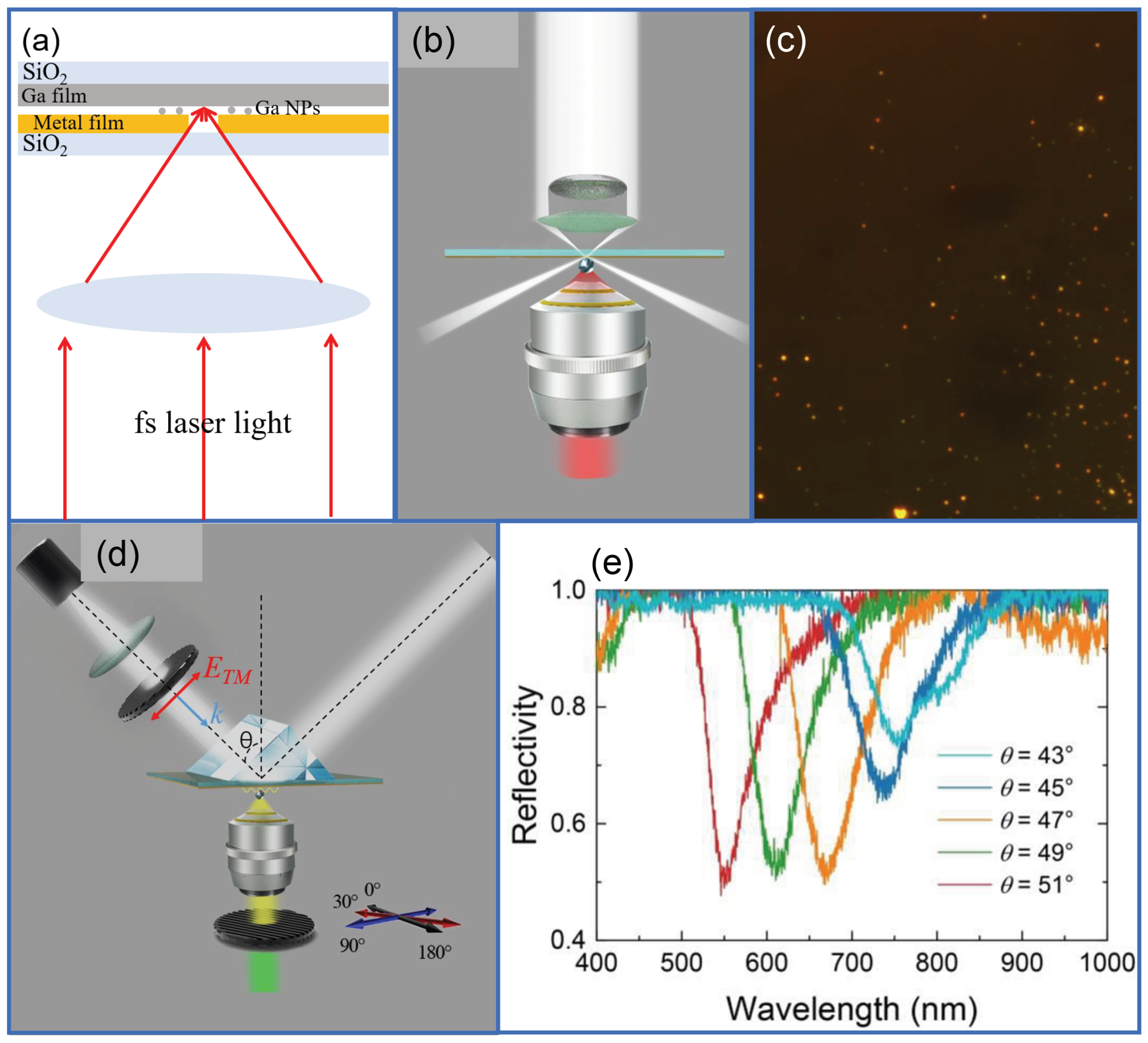
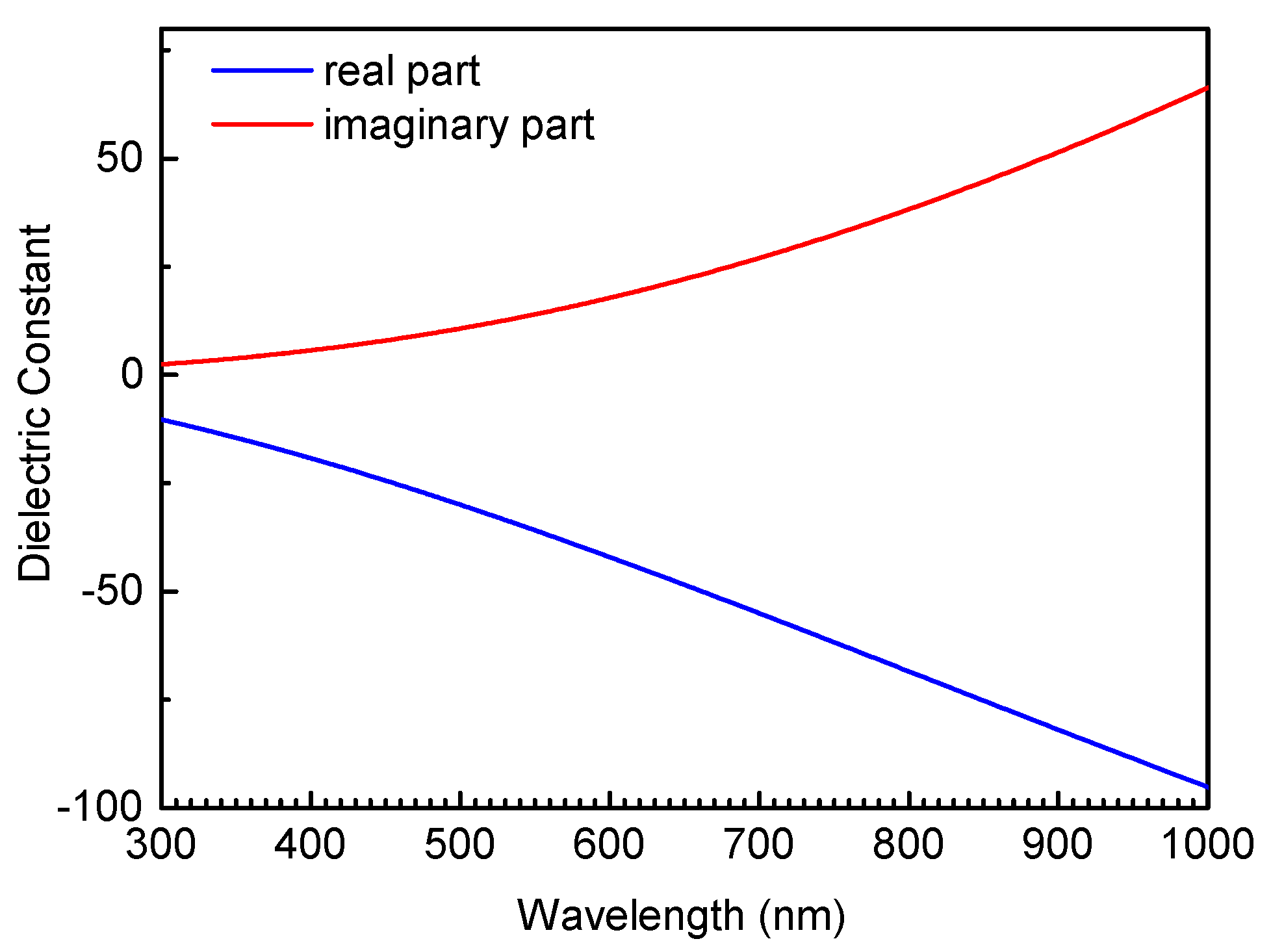
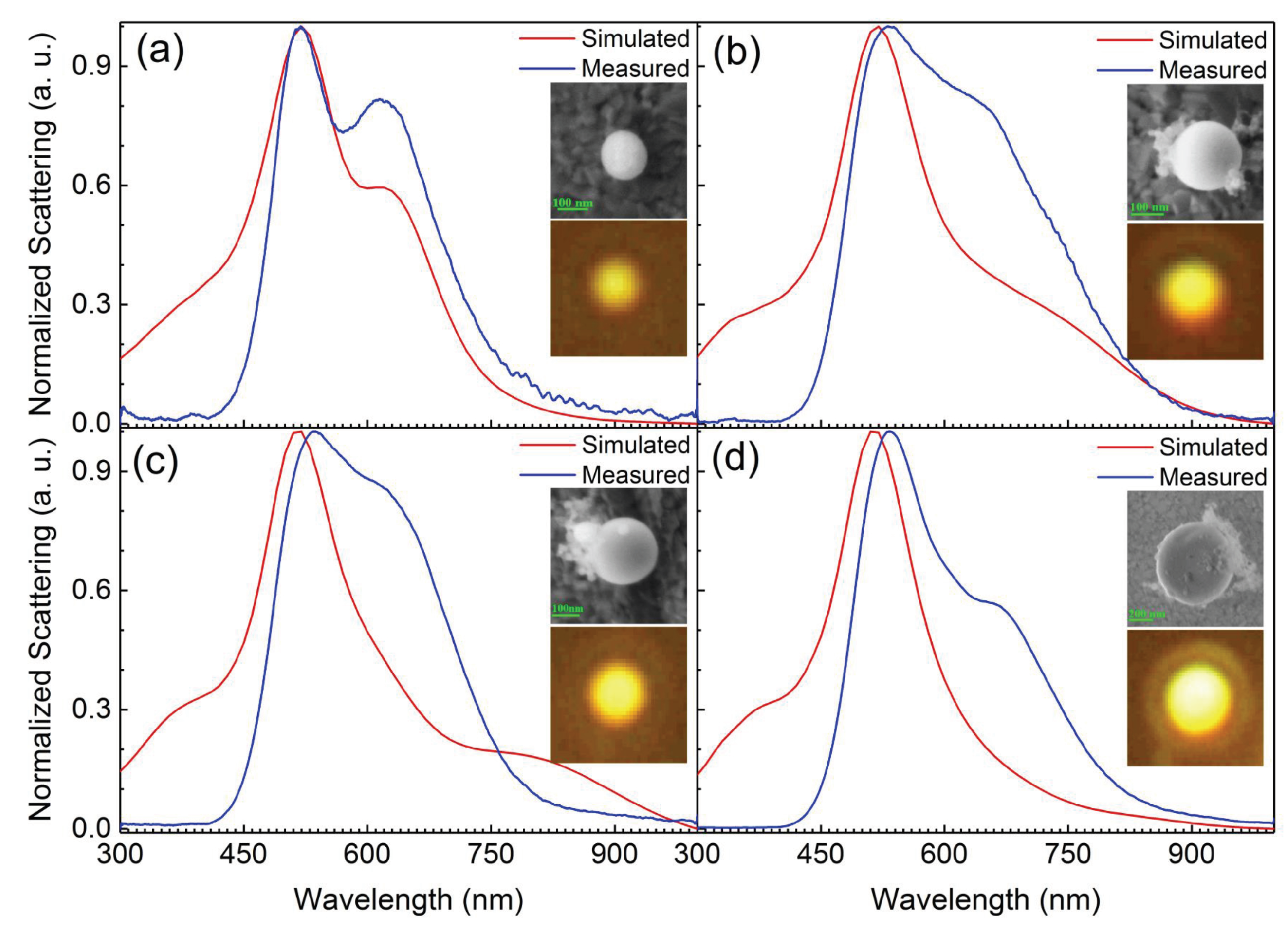
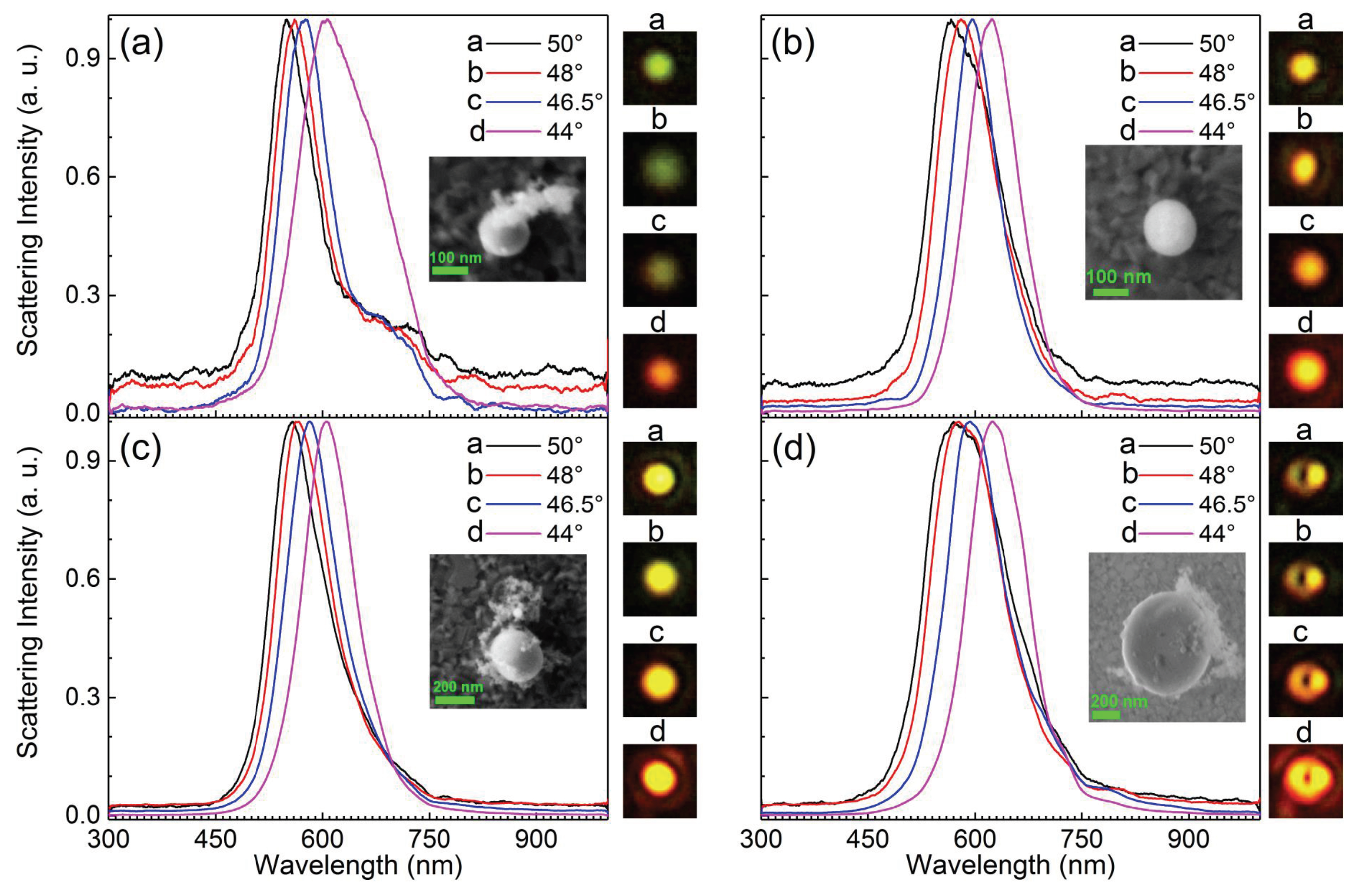
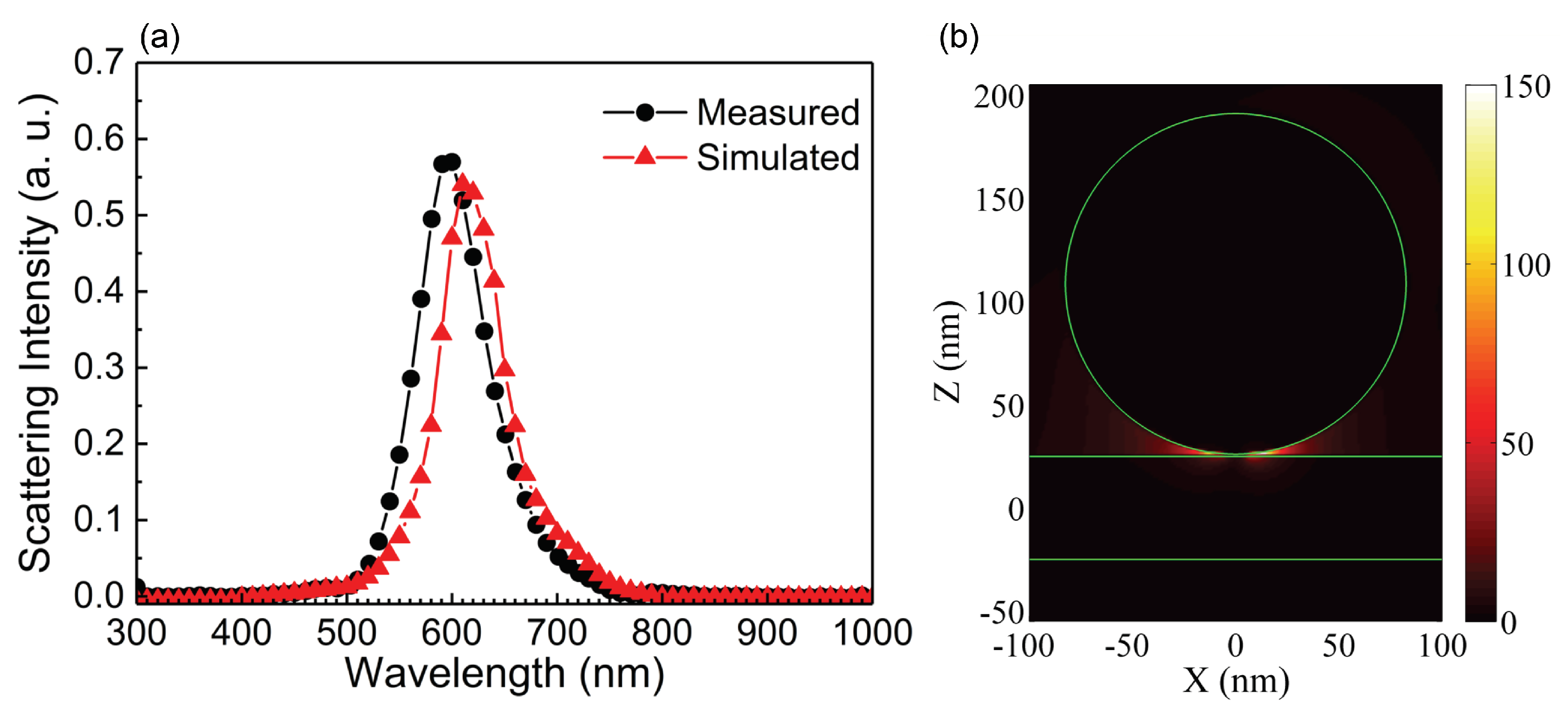

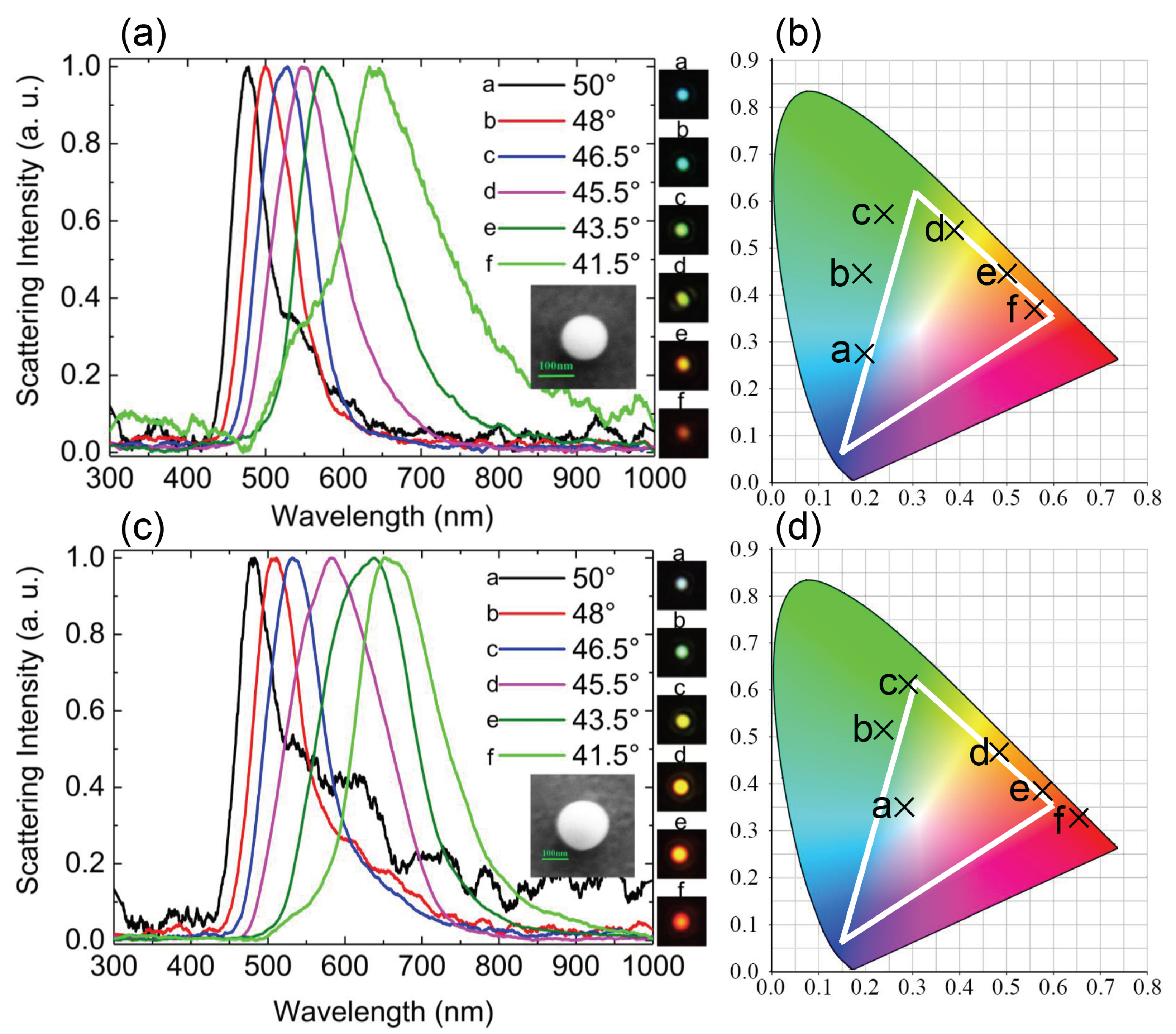
© 2020 by the authors. Licensee MDPI, Basel, Switzerland. This article is an open access article distributed under the terms and conditions of the Creative Commons Attribution (CC BY) license (http://creativecommons.org/licenses/by/4.0/).
Share and Cite
Deng, F.; Liu, H.; Peng, Y.; Panmai, M.; Lan, S. Optical Scattering of Liquid Gallium Nanoparticles Coupled to Thin Metal Films. Nanomaterials 2020, 10, 1052. https://doi.org/10.3390/nano10061052
Deng F, Liu H, Peng Y, Panmai M, Lan S. Optical Scattering of Liquid Gallium Nanoparticles Coupled to Thin Metal Films. Nanomaterials. 2020; 10(6):1052. https://doi.org/10.3390/nano10061052
Chicago/Turabian StyleDeng, Fu, Hongfeng Liu, Yuanyuan Peng, Mingcheng Panmai, and Sheng Lan. 2020. "Optical Scattering of Liquid Gallium Nanoparticles Coupled to Thin Metal Films" Nanomaterials 10, no. 6: 1052. https://doi.org/10.3390/nano10061052



